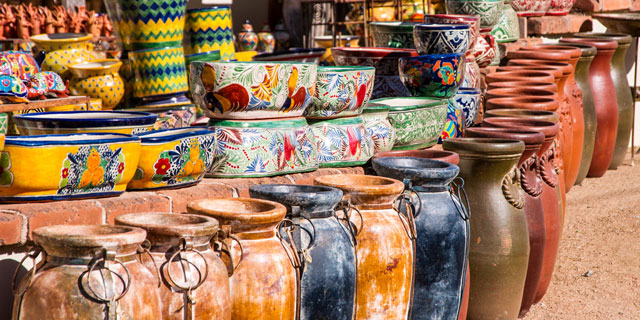Travel across Mexico, and you’ll see all sorts of signs of Spanish influence that date back to the colonial era. Architecture, of course, is chief among them—those ornate churches and stately, airy casonas that still demand admiration– but there’s also talavera, a type of pottery that was introduced to Mexico from Spain in the mid-17th-century. More than 300 years later, the popular style endures. The colorful ceramics are found in the form of decorative tiles (azulejos) adorning buildings’ exterior and interior walls (one of the most spectacular examples is the Casa de los Azulejos in Mexico City), as well as in the form of plates, bowls, and other serving dishes found in Mexican kitchens and on dining room tables.
Talavera isn’t just any kind of pottery, though, and not just any artisan can make it. The form, which is known in Spain as majolica, is a tin-enameled earthenware whose hard white glaze provides a backdrop against which the vivid glazes applied to it can visually pop. And those vivid glazes are selected carefully; in fact, for Mexican talavera to be considered authentic, it can only be painted in one or more of six colors– black, blue, green, orange, yellow, or mauve–all of which must be made of natural dyes and all of which must be painted onto the piece of tile or pottery by hand. The clay, a mix of a lighter and darker barro, must also come from Puebla and the forms into which it is shaped are fired twice. The process is hands-on, time-intensive, and elaborate.
In Mexico, the center of authentic talavera production is the state of Puebla, whose artisans have been renowned for the ceramic form since it was introduced to the country. In fact, Puebla has denominación de orígen status as the source of authentic talavera, and though the tradition of this art form originated in Europe, local producer Uriarte claims that Puebla is the largest producer of talavera in the world today.
The denominación de orígen designation, which is overseen by the Mexican Talavera Regulatory Council, certifies talavera as authentic. The process is rigorous, and once a workshop or producer achieves certification status, that designation is by no means assured. Each of the producers and their artisans must be recertified every six months. The close watch that’s kept on talavera production in Puebla does little to deter producers without certification from marketing and selling their wares as talavera, especially since so few visitors to Mexico who want to purchase the tiles and pottery know about the strict standards for its production. But for those who are in the know, the pieces of talavera made by the regulatory council’s certified workshops and producers carry special markings that affirm their authenticity. Look for “DO4” stamped on the bottom of the piece and a hologram sticker.
Here in the US, talavera is less a day-to-day functional object, as it is in so many Mexican kitchens, than it is pottery that is elevated as an art form. New York City’s Metropolitan Museum of Art, for example, has a collection of talavera that was donated over a century ago. If you’re in Mexico and you want to see how talavera is made, Uriarte, one of the certified producers, offers demonstrations at its headquarters in Puebla. You can also purchase authentic, D.O. talavera there, or at one of the city’s other certified workshops, including Talavera de la Reyna and Talavera de la Luz, which also operates a talavera museum.


![Making Mealtime Matter with La Familia: Easy Sofrito [Video]](https://thelatinkitchen.com/wp-content/uploads/2015/10/sofrito-shutterstock__0-500x383.jpg)
![Easy Latin Smoothies: Goji Berry Smoothie [Video]](https://thelatinkitchen.com/wp-content/uploads/2015/12/goji_berry-shutterstock_-500x383.jpg)
















![Fun and Fast Recipes: Fiesta Cabbage Salad [Video]](https://thelatinkitchen.com/wp-content/uploads/2015/11/fiesta_cabbage_slaw-shutterstock_-500x383.jpg)









